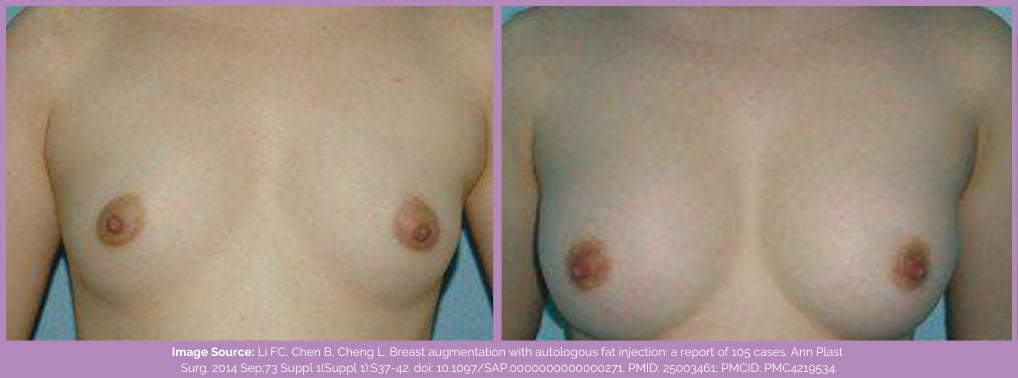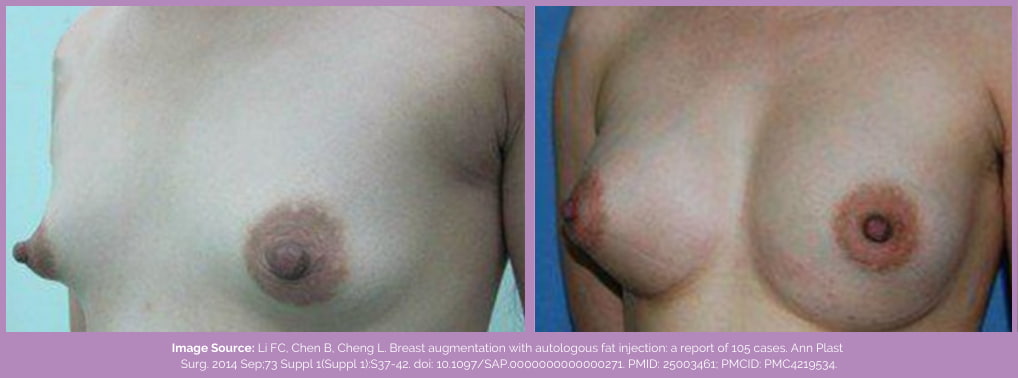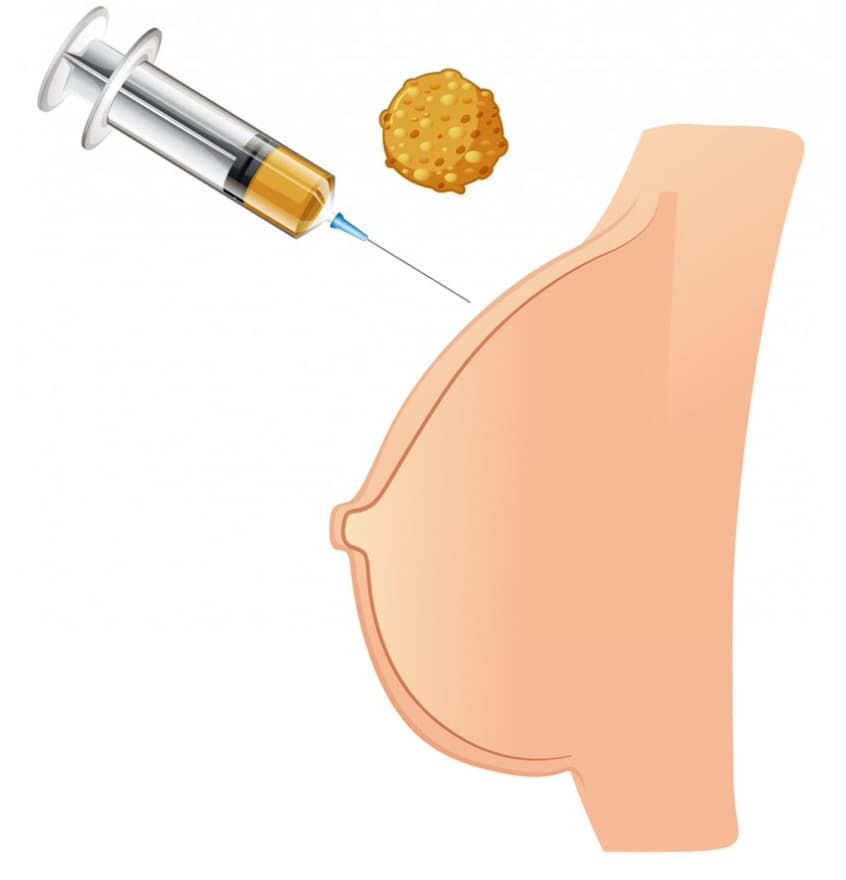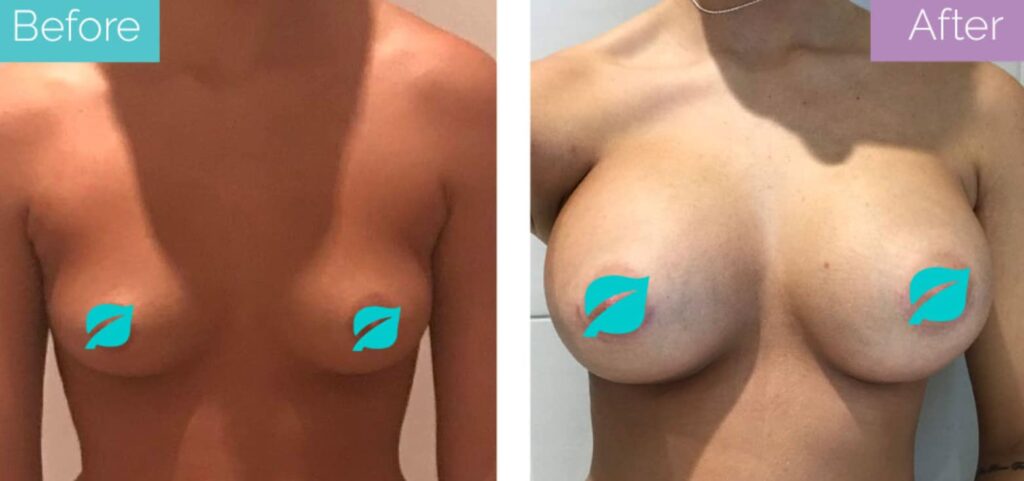Women who do not wish to have implants or plastic in their bodies often consider fat transfer for breast augmentation. Like a Brazilian Butt Lift (BBL), it uses fat to enhance the volume of the breasts and improve the appearance of the cleavage.
But while this procedure is presented as an alternative to an implant surgery, there are many differences you need to consider. And it comes down to the nature of fat itself and whether or not it will stay stable within your breasts. In this guide, you’ll learn more about fat transfer to breasts and how it compares to implants.
How Does Fat Transfer For Breast Augmentation Work?
Fat transfer breast augmentation, also known as autologous fat grafting, works through the harvesting of fat from different areas of the body through liposuction, such as:
- Abdomen
- Flanks
- Thighs
- Arms
Once this fat is taken out from the body, it’s centrifuged or washed for cleaning. This is then grafted into the breasts.

According to a study published in Seminars in Plastic Surgery, 200 mL of fat has usually been transferred to breasts at most to reduce the risk of fat necrosis while ensuring better results.
However, it’s possible to graft larger volumes of fat – up to 300 mL/breast – through an external tissue pre-expansion with the survival rate of the fat graft as high as 70-80%. This expansion device may need to be worn for weeks to a couple of months before the procedure.
But here, it’s important to note that this surgery is not for everyone. The first consideration for this surgery is the patient having enough fat for extraction.
If you’re very lean with not enough fatty deposits, it won’t be possible to graft a large amount of fat. But this procedure isn’t always standalone, as some surgeons combine it with breast implant surgery to improve results.
For instance, the edges of an implant may be visible from underneath the skin of patients with insufficient breast tissue or fat. Implants can also ripple due to thin breast tissue or weight loss.
In such cases, fat injections can help improve the final results. Fat grafting can even be done with breast lifts to improve the volume of the breasts as they’re being repositioned.
There can be other benefits of this procedure as well, but keep in mind that you might need multiple sessions of fat transfer to breasts to achieve your desired results.
What Are The Uses Of Fat Transfer To Breasts?
Other than helping increase the volume of the breasts or hiding an implant, there are more things that autologous breast fat grafting can do, such as:
- Restoring some of the breast volume following an implant removal surgery
- Reconstructing new breasts
- Making slight improvement to the appearance of breasts after reconstruction
- Making the breasts less wide and/or making them more symmetrical
Additionally, what’s known as “lipofilling” has also been used for treating patients with tuberous (tube-like/narrow) breasts.

One study published in the World Journal of Plastic Surgery reported that this technique is “safe and easy” to achieve natural results for such patients.
What Is The Cost Of Fat Transfer Breast Augmentation?
In the UK, fat transfer for breast augmentation can cost £7,500 on average. The cost of the procedure can vary depending on its complexity, such as the use of an expander, areas targeted for fat harvesting, and whether or not both breasts are being filled.
Moreover, the experience of the surgeon and the location of the clinic can also have an impact on the overall price. At the time of the booking, you should be clear with the clinic about what will be included in the price (from consultations to aftercare).
Does Fat Transfer To Breasts Hurt?
Fat transfer breast augmentation is done under anaesthesia, either local or general, so you won’t feel pain during the surgery.

However, you can feel pain in the donor areas and the breasts for some time after the surgery. Your surgeon should prescribe you painkillers to manage this.
How Long Does It Take To Recover From Fat Transfer Breast Augmentation?
Fat transfer for breast augmentation can have a downtime of 1 week. A few of the side effects that you can experience after the procedure include:
- Swelling
- Bruising
- Soreness
- Numbness
This list is not exhaustive, and you should make sure to consult your doctor about the post-op experience so that you’re better prepared.
During the recovery, however, you might have to wear a special bra that doesn’t put pressure on your breasts while they’re healing. To not put pressure, you might also have to sleep on your back for 1 month.
Moreover, you’ll have to wear a compression garment in the areas that have undergone liposuction for at least 6 weeks to reduce the risk of seroma formation.
Strenuous activities will also be advised against for maybe more than a month, although light exercises and walking might be okay for you after a couple of weeks (consult your surgeon about this first).
While bruising and soreness can go away in a few weeks, the swelling can persist for months to come, which can make your breasts look bigger than they’re actually going to be. Most of it will go away after 6 months, but you can see the final results a year after the procedure.
Does Fat Grafting To Breasts Leave Scars?
Since incisions are made during a fat transfer breast augmentation, it can leave scars. However, in general, they’re quite small (smaller than for implant surgery). Also, your surgeon will make sure that these are created in discreet areas so that they are not obvious.
For liposuction, multiple incisions might be made of 1-1.5 cm, and for the transferring of fat to breasts only a 3 mm incision might be needed.
How Long Does Fat Transfer Breast Augmentation Last?
The results of fat transfer to boobs can be permanent, but there’s a caveat: your breasts can lose volume.
The reason behind it is that the fat can be reabsorbed by the body, not all of it, but it could be up to half of what was originally grafted.
Because of this, it’s not really possible to predict how your results will look after some time. It’s not consistent like getting implants, which stay the same size.
What Are The Risks Of Fat Transfer Breast Augmentation?
While fat transfer breast augmentation has the advantage of not causing foreign tissue rejection by the body, the procedure carries certain risks. It can lead to:
- Fat necrosis
- Infection
- Oil cysts
- Induration (thickening and hardening of tissue)
- Changes to breast contour
- Calcifications
Some of the complications can also have serious consequences, such as the calcifications that can affect mammograms. These can look like breast cancer on them. Although according to the Cleveland Clinic, fat grafting to breasts doesn’t increase the risk of breast cancer.
It can cause other problems as well, such as the formation of a hematoma and seroma. You must ask your surgeon about all the potential complications beforehand.
According to a review published in the Aesthetic Surgery Journal, fat grafting for cosmetic breast augmentation had a complication rate of 17.2%, with indurations, pain and hematoma being the most common complications (in that order).
Can Fat Grafting Replace Breast Implants?
While fat grafting can be used for breast augmentation, they’re not ideal substitutes for implants. One of the main reasons for that is fat can be reabsorbed by the body, which can make the breasts lose volume even after the procedure.
In contrast, the volume of the implant you choose will remain the same (unless there’s a rupture). Therefore, the size of your breasts will consistently remain the same.
Another notable difference is how high up you can go with these two treatments. With fat grafting, you might notice a difference of a half to a full cup.
But with implants, the results can be far more dramatic. Fat transfers are limited by how much fat is available for harvesting. You might also need to expand your tissue before the surgery to accommodate more fat.

In spite of the fact that some women prefer fat transfer for breast augmentation because it feels more natural, the primary difference lies in the results. Here’s a summary of the differences between the two treatments:
| Fat Transfer Breast Augmentation | Breast Implants | |
| Procedure | Fat is harvested from different parts of the body through liposuction and injected into the breasts. | A specific type of implant (silicone/saline, smooth/textured and tear-drop/round) between 100-800 CCs is inserted into the breasts through incisions around the breast crease and/or nipples. |
| Candidates | Those who want to moderately increase the volume of their breasts or want to hide the implant edges due to insufficient fat or thin breast tissue. Can also restore volume in breast reconstruction or after explant surgery. | Increases the volume of breasts in cases of genetically small breasts, micromastia, loss of breast volume after pregnancy/weight loss, or after breast cancer surgery. |
| Anaesthesia | General or local | General or local |
| Surgery time | 1-3 hours | 1-2 hours |
| Downtime | 1 week | 1-2 weeks |
| Results | Immediately visible but swelling takes time to go down (6-12 months) and up to 50% of the transferred fat can be absorbed | Immediately visible but swelling can take 6 months to go down. The size of the implants stays the same. |
| Longevity | Permanent (although some of the fat can get reabsorbed) | 10-20 years or more |
| Risks | Fat necrosis, infection, oil cysts, calcifications, induration, etc. (consult your doctor) | Infection, scarring, sensation changes, hematoma, seroma, bleeding, implant complications, etc. (consult your doctor) |
| Cost | UK: £7,500 | UK: £7,000 Turkey: £2,500 |
Conclusion
Fat transfer for breast augmentation is often thought of as an alternative to breast implants, but before making a decision, you need to be clear on your desired cosmetic goals.
Fat transfer can be beneficial in many instances. It can even be combined with breast surgeries like lift and augmentation, but it depends on how much fat you have.
Moreover, there’s still no way of predicting the final results because the fat can be absorbed by the body (just like in a BBL).
Since these decisions cannot be easy to make, it’s always best to talk to a board-certified plastic surgeon. They’ll recommend a suitable treatment plan to you based on your needs.
Reviewed and approved by Prof Dr Fuat Yuksel

